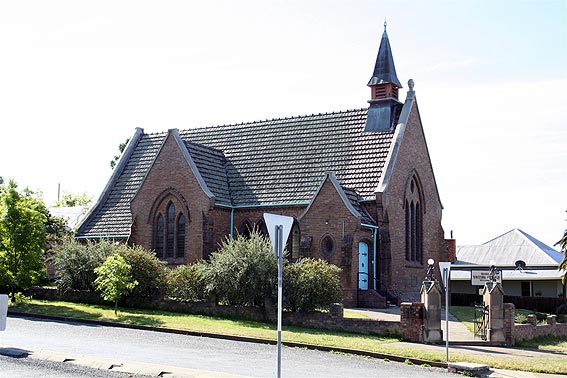
Munro Memorial Uniting Church, Quirindi
[Photograph by Trevor Bunning (September 2007)]

Munro Memorial Uniting Church, Quirindi
[Photograph by Trevor Bunning (September 2007)]
Historical and Technical Documentation by Richard Ward
© OHTA 2014 (last updated March 2014)1
In the early 1920s, Mrs Elizabeth Munro of Collarene, and her two daughters, gave £3,000 towards the building of the new Presbyterian Church at Quirindi as a memorial to her late husband, Hugh Munro, and their three sons.2 The building, of dark open-kiln bricks from Maitland, was designed by Sydney architect, J. Shedden Adam, and built by D. McNaughton & Son of Newcastle.
Munro Memorial Church was dedicated on 25 May 1921 by the Moderator of the Presbyterian Assembly of NSW, the Rt Revd John Edwards, assisted by the Revd Mr Racklyeft and neighbouring ministers.3
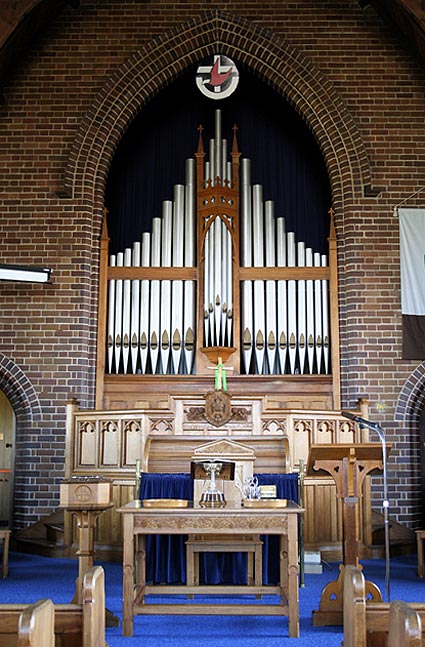
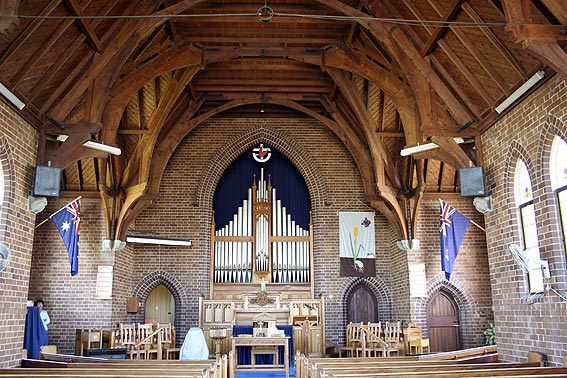
The 1921 Dodd organ in Munro Uniting Church, Quirindi
[Photographs by Trevor Bunning (September 2007)]
The organ at Quirindi was one of two organs built by Josiah Eustace Dodd of Adelaide in the early 1920s for new Presbyterian Church buildings (both now Uniting Church) in the New England region. The other was at Cameron Memorial Church, Glen Innes. Even though these organs were made at the same time, the Quirindi organ has mechanical action whereas the Glen Innes instrument was built with pneumatic action. The Quirindi organ survives unchanged while the Glen Innes instrument has been altered substantially, though retaining some of its Dodd character. The only other organ by Dodd in the north of NSW is his large instrument of 1912 built for St Carthage's Roman Catholic Cathedral, Lismore.
Organs built by J.E. Dodd are known for the combination of quality pipe work and artistic cases used in their construction. He had great ability as a tonal voicer in the romantic style and his organs were built according to romantic-symphonic principles.4
A special organ chamber was provided at the front the new building at Quirindi and a contract for a new pipe organ was made in 1921 with J.E. Dodd, of Adelaide. The organ, ordered at a cost of £600, was the gift of Miss Margaret A. Allison, of a family of wealthy graziers at Coomoo Coomoo.5 The organ was built to the specification of Sydney organist, Frederick Morley.6
Dodd was experiencing difficulties in his business at this time and his correspondence indicates that he had particular problems in communicating with his son Eustace who was working in Melbourne, Sydney and Tasmania. In February 1923, Dodd wrote to his son saying that he could not start on the Quirindi and Glen Innes organs until he had the specifications which Eustace appears to have taken with him.7 A letter to E.H. Wood (of Hawthorn, Victoria) in April 1923 checking on the pipe scales given by Eustace indicates that all of the metal pipes for Quirindi and Glen Innes were being made by Wood and that Dodd had still not commenced work on the soundboards for these organs.8 As a result of these delays, the Quirindi organ was not ready until late in 1923.
The organ was dedicated and opened on 12 December 1923. The Quirindi Gazette described the ceremony:
After the dedicatory prayer, the Rev. R. C. Racklyeft called on Mr. J. M. Allison to perform the opening ceremony, which he did by removing the Royal Standard of Scotland from the key board.9
The organ case is described:
The case is in oak, French polished. The arrangement of the front pipes consists of two flats, intersected by a large tower of pipes of the great diapason, with a smaller dulciana tower in the centre. The tower pipes stand on a massive moulded truss, and are surmounted with handsome bands in oak, richly carved and moulded. The pipes are decorated in gold and silver, the ground work being a rich silver shade.
The front pipes were silvered by Mr L. H. Turner, local coachbuilder and undertaker.
The Quirindi Gazette report gives a very full description of each of the organ stops and it is apparent that the copy for the article was provided by Josiah Dodd and quoted at length. It is interesting to note that Dodd sees organ tonal design in purely orchestral terms:
It is the aim of all organ builders to imitate the tone of the actual orchestral instruments themselves with the organ stops, and in this instance the organ builder has excelled.
The organ contains two manuals, ten speaking stops, and three couplers. To somewhat describe each individual stop. The Harmonic Flute (4ft) is typically an orchestral instrument, inasmuch as with the orchestral flute the lower notes are particularly reedy. This lends itself to solo work, and when played as a flute solo, in its true scale, as the descent is made into the bass, a true gamba tone results, giving a magnificent true orchestral flute effect, and it must be heard for one to realise its great beauty. This stop is the most beautiful and realistic we have ever heard, and several members of the audience were anxious to know what stop was used in the last number of the programme.
The Dulciana has a beautifully soft, undulating, silvery and slightly stringy tone, so suitable for soft and solemn pastoral effects in the sacred music.
The Claribel is full and round, resembling the French horn – in fact when used in solo work, one can imagine the French horn itself being introduced into the melodies. It is undoubtedly another very fine stop for all church work.
The Open Diapason on the Great is a typically fine stop, and can certainly be designated the "The King Stop" of every organ. In this case it is a full 6½ scale, and we understand was specially built to suit the acoustics of the building. Its sister stop – the Diapason on The Swell is of a similar character, but not so assertive as the one on The Great, which makes it a very serviceable stop in the psalmody of Church worship.
The Leiblich (sic) Gedact is beautifully flutelike and mellow in character throughout, and when coupled with the Viol d'Orchestra, and especially when the Tremulant is used in conjunction, produces an effect that can only be described as angelic.
The Salicional Oboe (and we understand is the first of its kind introduced into Australia), is most realistic. This is not a reed, but a large gamba to produce the Oboe effect, which enables it to remain definitely in tune. This method has been adopted for country organs to save the organ tuner's visits.
The most useless stop on any organ, as a rule, but imperative to include, is the Octave Diapason. This stop has been so skilfully treated in this instance that one can use it even in solo work. It also builds up the harmonics in the organ, and when used with the grand ensemble gives a most brilliant and full effect.
The pedal board is typically of the Australian school, being built according to the rules and regulations of the Adelaide Conservatorium of Music, and is an improvement on the old Wesley-Willis make – the father of all organ builders. According to more modern ideas the old style of spacing the pedals is too close at the heel to permit one foot being placed behind the other with such ease as under the improved system. The draw-stops are arranged in upright jambs on either side of the key-board. Both the draw-stops and the pedals are designed on the tubular-pneumatic action, and their response is immediate. There are two composition pedals to The Swell and two to The Great, and the Tremulant is worked by a hitching pedal. The Balanced Swell pedal is placed in the centre of the pedal board, and can be used with ease by either the right or the left foot. The key-board and pedal board in relation to each other are constructed according to the L.R.C.O. rules. Every stop on the organ is a solo stop.
The action to the manuals is mechanical, with long trackers (along with pneumatic tubes for the stop and pedal actions) running from the console, under the pulpit, to the organ:
The console, which contains the key-boards, drawstop mechanism and aids, operable by the performer, as placed some 10 feet in front of the instrument, with the pulpit intervening. Notwithstanding the distance between the two vital sections, the touch and speech of the pipes are instantaneous and immediately responsive in the most rapid passages.
An organ recital was given at the time of the opening:
Mr. Wilfred Arlom, a rising musician of repute in metropolitan circles, came up to give the opening recital, and a very large congregation gathered to appreciate the musical treat which he provided.
The programme, lasting for two hours, included the following pieces on the organ:
Mendelssohn - Sonata No. 6
Guilmant - Prayer & Cradle Song
Rachmaninoff - Prelude in C sharp minor
Lizst - Consolation
Bach - Three works
Dvorak - Humoresque
[Boëllman] - Suite Gothique
This instrument survives in a substantially unaltered condition and is a rare example of a mechanical action organ in the region. The predominance of 8ft tone does, however, mean that the tonal range is rather limited for modern taste.
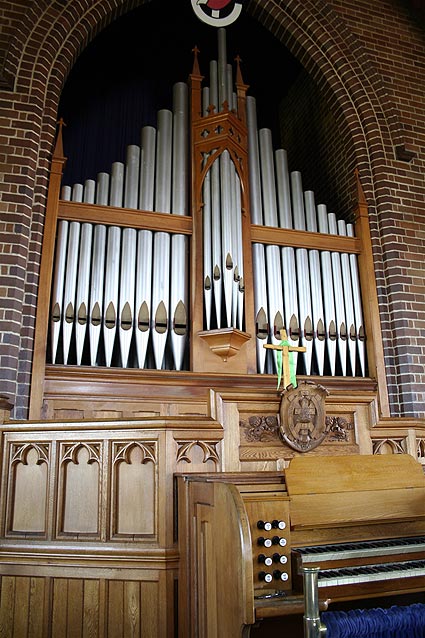
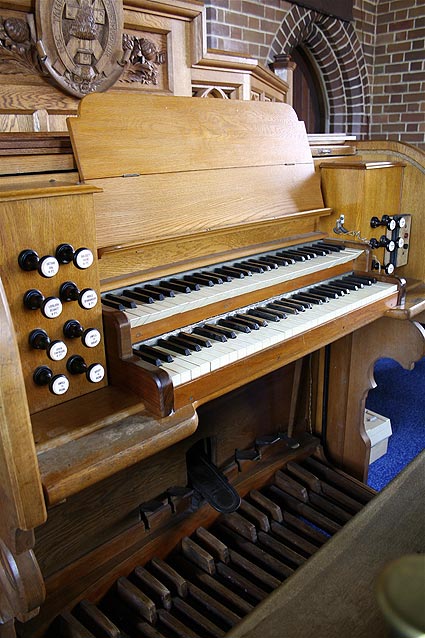
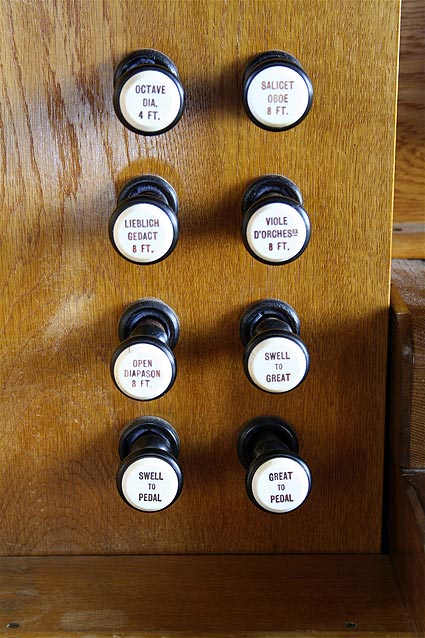
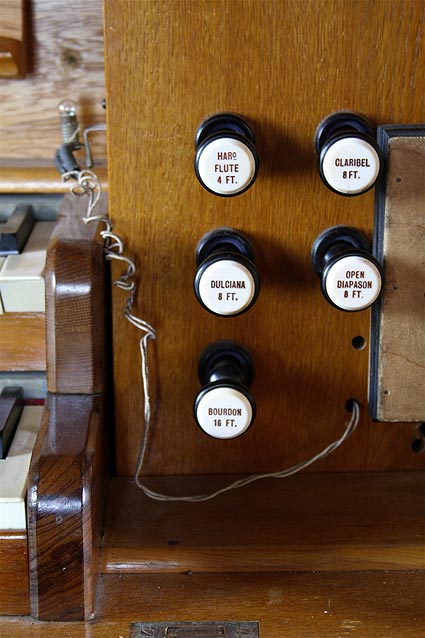
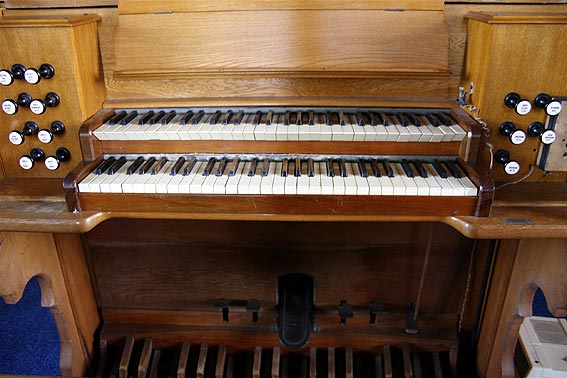
Console details of the 1921 Dodd organ
[Photographs by Trevor Bunning (September 2007)
The specification is:
Great |
8 8 8 4 8 8 8 4 8 16 |
* |
* reed pipes to Tenor C
Compass: 56/30
Tubular-pneumatic action
Mechanical action to manuals
Pneumatic action to pedals
Tremulant by hitch pedal
Balanced swell pedal
2 composition pedals to Great
2 composition pedals to Swell

[Photograph by Trevor Bunning (September 2007)]
________________________________________________________________________________
1. The material presented here was published originally as part of: Richard Ward, 'The Dodd Organs in New England,' The Sydney Organ Journal, vol. 41, no. 3 (Winter 2010), pp. 31-36.
2. Dorothy Durrant, Quirindi 1919-1939: Between the World Wars (Quirindi: Dorothy Durant, 1997), pp. 36-37.
3. 'Munro Memorial Church, Dedication by the Right Rev. The Moderator,' The Quirindi Gazette (10 June 1921).
4. Bruce Naylor, 'Dodd, Joseph Eustace (1856-1952)', Australian Dictionary of Biography, vol. 8 (Carlton: Melbourne University Press, 1981), p. 314.
5. The Sydney Morning Herald (1 June 1921), p. 9.
6. Graeme D. Rushworth, Historic Organs of New South Wales: The Instruments, Their Makers and Players 1791-1940 (Sydney: Hale & Iremonger, 1988), p. 193.
7. J.E. Dodd, Copy of letter to E. Dodd, 22 Feb 1923.
8. J.E. Dodd, Copy of letter to E.H. Wood, 28 Apr 1923.
9. 'New Pipe Organ. Dedication and Opening,' The Quirindi Gazette (11 January 1924).